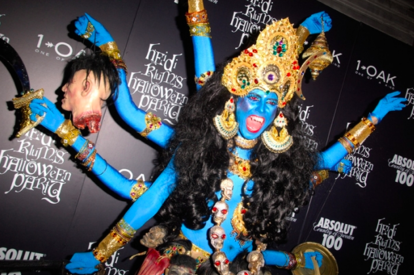Cultural Appropriation of Indian Culture in the Media
Cultural Approrpriation Defined
Cultural appropriation is the usage of a culture’s symbols, genres, rituals, artifacts or technologies by individuals from other cultures.[1] Cultural appropriation differs from cultural appreciation, where appreciation involves honouring the sources from which elements of a culture originated from as well as valuing, and understanding of the item and its culture.[2]
Negative Connotations of Cultural Appropriation
Cultural appropriation is viewed as the wrongful oppression of a marginalized culture and the stripping of its group identity and intellectual property rights.[2] It is frequently discussed in terms of cultural exploitation, where individuals of dominant cultures adopt elements from minority cultures without substantive reciprocity, permissions and/or compensation.[1][3] Cultural exploitation typically involves appropriative acts that indicate a positive evaluation or acceptance of a colonized culture yet reinforce the dominance of the colonizing culture.[4] For instance, it makes certain elements “cool” for individuals from dominant cultures to adopt, while too “ethnic” for people of colour. It also spreads misconceptions about marginalized cultures.[5]
Cultural Appropriation in the West
Canadian economic and social development has been largely shaped by immigrants settling in Canada. Inevitably, immigration has impacted cultural connections and media in the West today. [6] Symbols of South Asian femininity have translated in the Western media as the apex of high fashion[7].
Cultural appropriation is not simply the act of partaking in cultural symbols that do not belong to an individual; rather, it is a system of exploitation and capitalization of cultural symbols and practices that do not originate from, benefit, nor circle back to the culture in question.[6] In this way, cultural appropriation can be understood in terms of imperialism and dominance.
Examples of Cultural Appropriation
Cultural Appropriation of the Bindi
The bindi, a coloured dot worn in the centre of the forehead, traditionally symbolizes Hindu femininity.[7] Though originally indicative of adherence to Hindu spirituality, the bindi has gained popularity beyond Indian shores as a trendy fashion accessory.[8] In the West, many celebrities wear the bindi for commercial and aesthetic purposes, although many Indian women wearing the bindi outside of cultural contexts are looked down upon for their failure to assimilate.[1]
Gwen Stefani wearing a bindi.
Cultural Appropriation of Mehndi/Henna
The art form of mehndi, also called henna, has been practiced for thousands of years in India, Africa, Pakistan and the Middle East.[9] In India, henna is commonly reserved for special occasions, such as wedding traditions amongst Muslim and Hindu brides. Prior to a Hindu wedding, the bride and the women in her family have their henna applied with symbolic and historical designs that signify the love between the groom and bride. This custom holds cultural significance, as it is believed that the darker the henna appears on the skin after removal, the deeper the love will be within the marriage.[9] In the West, henna has become a fashion statement for many individuals who lack knowledge about the origins or applicability of henna to many cultures.[9]
For example, Madonna was seen wearing elaborate designs with mehndi in her Frozen music video. She later appeared at the 1998 MTV Video Awards decorated with Hindu religious symbols[7].
Madonna wearing henna and multiple bindis at the MTV Video Awards.
Cultural Appropriation of Indian Attire
Traditional Indian attire is frequently used as a fashion symbol by Western popular culture. For instance, the salwar-kameez is an outfit that holds cultural importance, as it contains stitching and suturing that reflects the many terrains and textures in which the women are situated [10][11]. However, even British-Asian entrepreneurs today have reformulated “ethnic” traditions through filters of their local cultures[12].
Iggy Azalea wore a variety of traditional clothing in her video Bounce, such as the sari, lengha, as well as the bindi and chakra, a headpiece that holds value within the traditions of Hinduism, all without understanding India's culture or history.[13] [14]
Cultural Appropriation of Sacred Figures
Many celebrities have dressed as sacred religious figures for aesthetic purposes. For Halloween, Heidi Klum dressed as Kali, a Hindu goddess. Many followers of the Hindu faith expressed anger towards Klum's actions, as Goddess Kali is "meant to be worshipped," not be used as a Halloween costume.[15]
Heidi Klum posing as Goddess Kali.
Impact
Misrepresentation is the incorrect representation of facts, statements, or characters of an individual; when individuals engage in cultural appropriation, there is often a misrepresentation of culture[16]. Cultural appropriation reinforces the idea that individuals from dominant cultures are free to co-opt and adopt cultural ways of living, traditions, or items without understanding or acknowledging their relative position of power. Many view cultural appropriation as “stealing” from a culture’s intellectual property or cultural expressions. Furthermore, many individuals from minority cultures are concerned with cultural degradation, cultural preservation, wrongful exploitation for financial gain, and failure to recognize sovereign claims[17].
For example, Azalea misrepresented Indian culture by depicting India in stereotypical ways in her video "Bounce." She depicted India as merely "poor" and "dirty," while also riding an elephant. In an interview, she stated that she included an elephant for "good luck"[18]. Thus, rather than understanding and respecting the diverse culture of India, she perpetuated stereotypes and misrepresented Indian culture, while financially benefitting from the video.
Movements Against Cultural Appropriation
#ReclaimTheBindi
ReclaimTheBindi calls for the stop of the use of cultural, religious and spiritual clothing or accessories by individuals who do not belong to the groups in which these items are meaningful.[19] It particularly focuses on the bindi, which has been widely used amongst celebrities who are Caucasian, who exotify the bindi or wear it to appear “boho” or “hipster.” [20] To further the movement, Indian women upload pictures of themselves wearing bindis and using the hashtag #ReclaimTheBindi. The primary social media platforms utilized are Twitter, Tumblr, and Instagram.
Culture Not Costume
The Culture Not Costume is a poster ad campaign against cultural appropriation. Although it doesn’t target the appropriation of a single culture, it uses powerful visualizations to raise awareness of cultural appropriation. The campaign features students of various ethnicities holding photographs of individuals dressed in Halloween costumes that are perceived as culturally insensitive.
See also
References
- ↑ Jump up to: 1.0 1.1 1.2 Rogers, R. A. (2006). 'From cultural exchange to transculturation: A review and reconceptualization of cultural appropriation. Communication Theory, 16(4), 474-503.
- ↑ Jump up to: 2.0 2.1 Fragoso, B. (2016). Cultural Appropriation Vs. Cultural Appreciation. Retrieved from https://www.theodysseyonline.com/cultural-appropriation-vs-cultural-appreciation
- ↑ Rasmussen, B. (2001). The making and unmaking of whiteness. United States: Duke University Press.
- ↑ Buescher, D. T., & Ono, K. A. (1996). Civilized colonialism: Pocahontas as neocolonial rhetoric. Women's Studies in Communication, 19(2), 127-153.
- ↑ Johnson, M (2015, June 14). What’s Wrong with Cultural Appropriation? Retrieved from https://everydayfeminism.com/2015/06/cultural-appropriation-wrong/
- ↑ Jump up to: 6.0 6.1 Young, C. (2015). The hysteria over 'cultural appropriation'. Retrieved from https://www.pressreader.com/usa/the-washington-post-sunday/20150823/282029030975520
- ↑ Jump up to: 7.0 7.1 7.2 Durham, G. (2001). 'Displaced persons: Symbols of south asian femininity and the returned gaze in U.S. media culture. Communication Theory, 11(2), 201-217. doi:10.1093/ct/11.2.201
- ↑ Antony, M. G. (2010). On the spot: Seeking acceptance and expressing resistance through the bindi. Journal of International and Intercultural Communication, 3(4), 346-368.
- ↑ Jump up to: 9.0 9.1 9.2 Oberlender, I. (n.d.) Henna: Cultural appreciation or cultural appropriation? Retrieved from http://www.herculture.org/blog/2016/5/3/henna-cultural-appreciation-or-cultural-appropriation#.WfoDyRNSzOQ
- ↑ Bhachu, P. (1996). The multiple landscapes of transnational Asian women in the diaspora. Re-situating Identities. The Politics of Race, Ethnicity and Culture, 283-303.
- ↑ Bhachu, P. (1993). Identities constructed and reconstructed: Representations of Asian women in Britain. Migrant women: Crossing boundaries and changing identities, 99-117.
- ↑ Jackson, P. (2002). Commercial cultures: Transcending the cultural and the economic. Progress in Human Geography, 26(1), 3-18. doi:10.1191/0309132502ph254xx
- ↑ Walton-Roberts, M. (2003). Transnational geographies: Indian immigration to canada. The Canadian Geographer, 47(3), 235-250. doi:10.1111/1541-0064.00020
- ↑ Rohloff, L. (2014, April 21). Cultural Appropriation and Bounce. Retrieved from https://wst281481spring2014.wordpress.com/2014/04/22/cultural-appropriation-and-bounce/
- ↑ PTI. (2008, November 5). Heidi Klum's 'Kali act' leaves Hindus fuming. Retrieved from https://timesofindia.indiatimes.com/world/Heidi-Klums-Kali-act-leaves-Hindus-fuming/articleshow/3677674.cms
- ↑ Young, J. O. (2005). Profound offense and cultural appropriation. The Journal of aesthetics and art criticism, 63(2), 135-146.
- ↑ Ziff, B. H., & Rao, P. V. (1997). Borrowed power: Essays on cultural appropiation. New Brunswick, N.J: Rutgers University Press.
- ↑ Thomas, S (2013, August 26). Iggy Azalea and a culture of appropriation. Retrieved from https://mediadiversified.org/2013/08/26/iggy-azalea-the-vmas2013-and-a-culture-of-appropriation/
- ↑ Madrid, I (2015, April 14). Reclaim the Bindi Calls Out Coachella Appropriators. Retrieved from https://www.good.is/articles/reclaim-the-bindi
- ↑ Pavraja (2016, July 8). Cultural Appreciation vs Cultural Appropriation: An interview with the founder of Reclaim the Bindi. Retrieved from https://pigmentpress.org/2016/07/08/cultural-appreciation-vs-cultural-appropriation-an-interview-with-the-founder-of-reclaim-the-bindi/
Submitted by: Gagan Cheema



